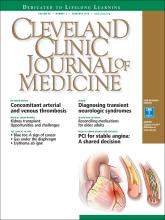
Sharing medical decisions with patients is important but complicated, and we often do not do it well. Many decisions seem too minor, some involve few alternatives, and for some we do not know enough about the background data even though we are comfortable with the “right” medical decision. And there is always too little time to discuss in detail any but the most important decisions.
It is difficult to provide enough information for informed consent and to ensure that the patient and his or her family fully understand what we are saying. Patients often come in with their own preferences and biases based on anecdote, dinner conversations, or the Internet. The physician must push hard to dispel a patient’s bias with the facts, while recognizing that we too regularly present “facts” and recommendations colored by our own biases based on anecdotal experience, professional ritual, and intellectual hubris.
Two articles in this issue of the Journal, one by Dr. Michael Rothberg1 and the other by Dr. Umesh Khot,2 examine percutaneous coronary intervention (PCI) in patients with stable chronic angina. Both discuss the findings of the Clinical Outcomes Utilizing Revascularization and Aggressive Drug Evaluation (COURAGE) trial3 and how to use these findings in helping patients decide whether to undergo PCI.
Rothberg and Khot agree that in the COURAGE trial, PCI effectively if not completely reduced angina but did not decrease the likelihood of death or subsequent myocardial infarction (MI). Patients were excluded from the study if they had a likelihood of left main disease, heart failure, or severe angina. All underwent catheterization, and all were given optimal medical therapy. Thus, the trial results do not directly relate to every patient with stable angina.
While the patient may find it confusing that angina and the risk of MI are not reduced in parallel, since both are due to atherosclerosis, their dynamic pathophysiology is different. The COURAGE results are the mirror image of those in some early studies of aspirin in coronary disease, in which aspirin reduced the incidence of MI but did not significantly affect angina.
In view of the COURAGE results, Rothberg seems surprised that PCI continues to be frequently used in patients with stable angina. He points out that according to some surveys,4 not all cardiologists have embraced these (and other similar study) results. But as Khot notes, the use of PCI in stable angina has decreased. More interesting to me were the results of an online study conducted by Rothberg and colleagues in which participants were provided different background information about PCI.5 Even if given explicit information that PCI did not prevent MI, a fair number still said they would choose it and still believed it would prevent this outcome. Bias clearly influences what patients read and hear, and they bring these biases into the shared decision-making process.
While some patients may not fully understand PCI’s risks and putative benefits, others may choose it because of their personal knowledge of others’ experience or perhaps because the “softer” benefits demonstrated in COURAGE and other trials are important to them. As outlined by Khot, patients who underwent PCI had more rapid relief of angina symptoms, possibly experienced greater relief of symptoms even if incomplete, and needed less medication. More patients needed urgent revascularization in the medical group than in the PCI group. Rothberg appropriately notes that this did not “equate to a reduction in the rate of MI,” but to some patients (eg, international travelers, caregivers) this higher possibility of needing an urgent procedure may be enough to make them want the initial elective procedure. While patients should be told that many of the patients in the medical therapy group in COURAGE crossed over to get PCI (16% at 1 year, and about 1/3 after a median of 4.6 years of follow-up), a patient for whom avoiding invasive procedures is the highest priority will likely “hear” that he or she has a 2/3 likelihood of not needing PCI without being at increased risk of death or MI with medical therapy.
As Rothberg points out, “providing information alone is not enough.” The patient needs to recognize, verbalize, and perhaps rank his or her own biases, fears, and desires. Equally important, we need to recognize our own biases and not let them overshadow the patient’s concerns.
I urge you to read both articles, not only because they offer excellent critiques of the COURAGE results and what they mean in practice, but also because they should make us reflect on how often and well we engage in shared decision-making with our patients. Reading these made me realize that I need to better understand my patients’ concerns. Discussing my interpretation of clinical study results, no matter how sophisticated or correct, and then offering a recommendation without fully understanding the patient’s treatment goals is not shared decision-making. The seemingly “wrong” decision may be right for the patient.
- Copyright © 2018 The Cleveland Clinic Foundation. All Rights Reserved.






